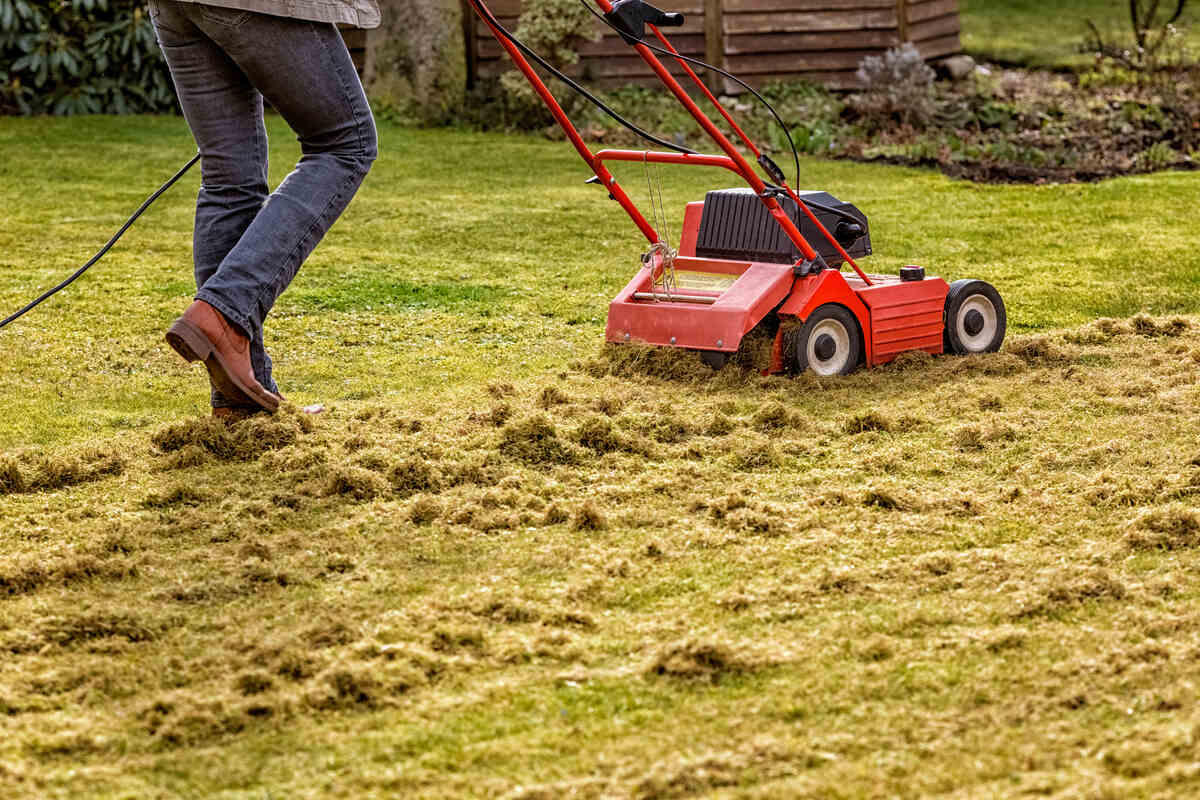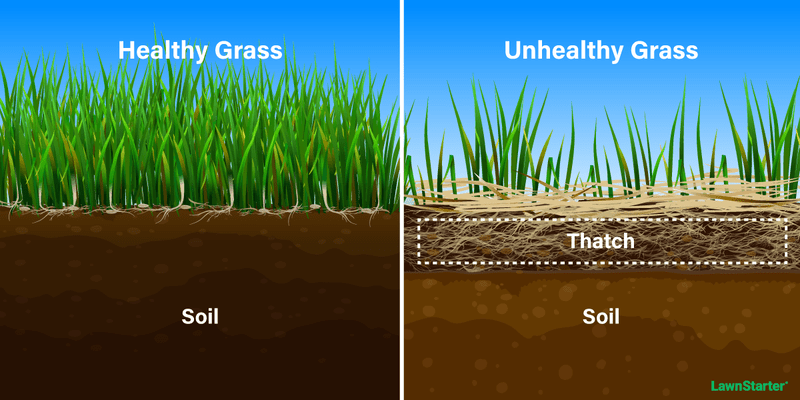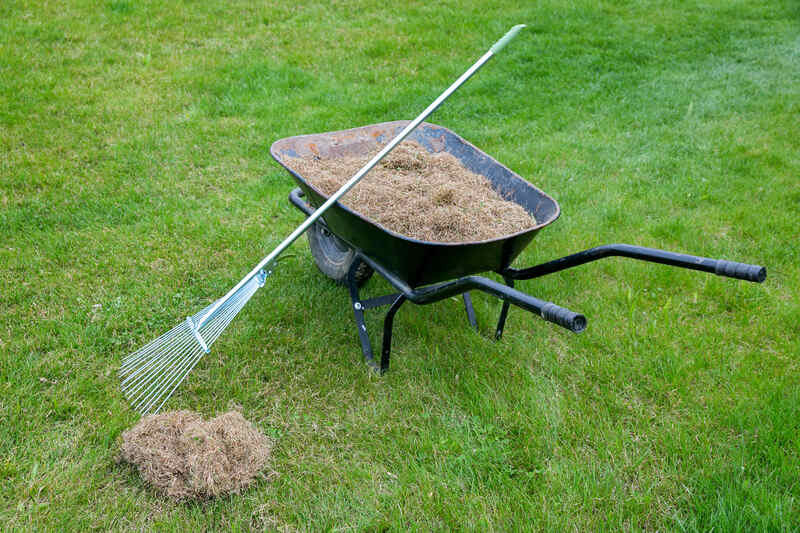
Knowing how to dethatch your lawn is simple: Wait for its growing season, mow the lawn shorter, then use a manual rake, a powered dethatcher, verticutter, or liquid dethatcher to thin out the thatch.
For you, it’s a few hours of work. For your lawn, it promotes a year of healthy growth. Dethatching breaks the tight cover of organic debris on the soil and lets in more air, water, and nutrients to feed the growing grass. We’ll tell you how to dethatch your lawn to reap all the benefits.

Thatch is the layer of dead and living roots, runners, and stems that forms between the soil and the grass. When it becomes 1/2-inch deep, it’s time to dethatch to keep your lawn healthy.
The best time to dethatch the lawn is when the grass is actively growing and can recover easily: late spring to early summer for warm-season grasses and late summer to early fall for cool-season grasses.
See Related: What is Thatch in Your Lawn?
Prepare the Lawn
Preparing the lawn correctly protects the grass, prevents accidents, and helps you get better results. Here’s how to prepare the lawn for dethatching:
- Clean the lawn: Remove debris like stones, twigs, and toys.
- Mark shallow irrigation lines, utilities, and sprinkler heads to avoid damaging them (especially important for verticutters). You also can mark sprinkler heads with flags.
- Mow the lawn shorter than the usual mowing height but not lower than the minimum recommended for your type of grass. Also, bag the grass clippings, or they’ll add to the debris you collect after dethatching.
Manual Dethatching: Best for Small Areas

| Project difficulty: Moderate Estimated time to complete: If you use a dethatching rake, expect to work about an hour to dethatch 250 square feet — including the mowing, dethatching, and cleaning the debris. Estimated cost: A dethatching rake costs around $30. |
Manual dethatching uses a rake and body force, so it’s only practical for small lawns or lawn sections. It is labor-intensive and time-consuming. On the other hand, manual dethatching is gentler with the grass and costs less than dethatching with a machine.
Best for: Lawn sections or small lawns with thatch less than 1-inch thick
Tools:
- Good-quality garden gloves
- A dethatching rake. If you don’t have one, use a regular garden rake.
- Goggles for eye protection
Step-by-step:
- If it’s a large area, divide it into sections and dethatch one at a time, pausing to rest.
- Rake with a push-and-pull motion. As you pull the rake toward you, you pull out debris and bits of thatch. When you push it backward, you clean the debris from the rake’s blades.
- Rake small rows until debris piles up. Then, move the debris to the side and continue. This way, it’s easy to see where you dethatched and what areas are left.
- Rake and collect the debris. For a 1,000-square-foot lawn, expect 2-3 lawn waste bags. You can use the debris as mulch in the garden, add it to the compost, or bag it for curbside recycling. You also can use a lawn mower with the bag attachment to collect the debris.
Pro Tip: Don’t push the rake too deep into the ground. If you see small pieces of thatch and dirt coming up to the surface, that is deep enough.
This video shows you how to approach manual dethatching on an average lawn.
See Related: How to Use Compost in Your Yard
Powered Dethatching: Best for Most Lawns
| Project difficulty: Moderate Estimated time to complete: About 40-45 minutes to cover 2,000 square feet. Estimated cost: A corded electric lawn dethatcher typically costs about $150 for a basic model. If you need a more powerful dethatcher, rent a gas-powered model for around $65 for a 4-hour period. |
Using this method is less physically demanding and takes less time than manually dethatching your lawn. On the other hand, it is more aggressive with the grass and more expensive.
You can buy a dethatcher if you plan on taking on this task regularly or rent a dethatcher if it is a one-time job. If you’re not familiar with dethatching machines and your lawn has thick thatch, another option is to contact one of our lawn care professionals to perform this task for you.
Best for: Medium to large lawns (1/2 acre or larger)
Tools:
- Any engine-powered dethatcher, such as a power rake
- Garden rake
- Goggles and ear protection
Here’s how to dethatch the lawn with a powered dethatcher:
- If you own a dethatcher, adjust the height of the blades or tines. They shouldn’t go deeper than 1/2 inch into the soil. If it’s a rental, ask the rental store to adjust the blades for you and get detailed instructions on how to use it.
- Test the dethatcher on a section of the lawn that is less visible to get some experience.
- Go over your lawn two or three times in different directions, similar to how you mow the grass.
- Rake and collect the debris. You also can use a lawn mower with the bag attachment for easier cleanup.
This video shows the basic steps of using a mechanical dethatcher.
Verticutting: Best for Thick Layers of Thatch
| Project difficulty: Hard Estimated time to complete: From 1 to 3 hours to mow, verticut, and rake the debris. Larger lawns might take longer. Estimated cost: Electric dethatchers often come with a set of blades that can turn them into a verticutter. They can be found in your home improvement store or purchased online for around $120 to $160. You also can rent a verticutter for around $90 per day. |
Verticutting removes thatch from your lawn by cutting grooves into the soil. The verticutter (or vertical mower) has vertical blades that cut through the thatch layer and bring it to the surface.
Verticutting is mostly done with professional-grade machines that you can rent from home improvement or rental stores. But some residential dethatchers come with blades you can swap out instead of the tines to perform verticutting with your home dethatcher.
Best for: Lawns with a thick layer of thatch (up to or over 1 inch)
Tools:
- A verticutter
- A garden rake
- Goggles and ear protection
Here’s how to dethatch your lawn using a verticutter:
- Water the lawn 2 days prior. Irrigate like you normally would (ideally, in a 30-minute session with 1/2 inch of water).
- Set the blades. For thin grasses (such as fine fescues) set the blades 3 inches apart since these grasses can’t handle much damage. For thicker turfgrasses, such as Bermudagrass, you can set the blades to a lower position (around 1 inch apart) to intensify the verticutting process. If you’re renting a verticutter, ask the rental store for your desired blade setting.
- Test the verticutter on a small section of the lawn to see if it’s adjusted to the right depth.
- Go over your lawn from one corner to the other in straight lines (north-south). Then, go over in the opposite direction (east-west), making perpendicular lines.
- Rake and collect the debris.
Note: Scarifying your lawn is another option if you’re dealing with a thick thatch layer. It is a more aggressive method than verticutting, as the blades cut deeper into the ground, but the process is the same. You can buy residential scarifiers or simply adjust verticutter blades closer together for a more aggressive approach.
Liquid Dethatching: Best for Thin Layers of Thatch

| Project difficulty: Easy Estimated time to complete: 15 to 30 minutes per application Estimated cost: $30 to $45 (Depending on product and lawn size) |
Liquid dethatching (also called chemical or microbial dethatching) uses liquid products sprayed on the lawn to boost the population of soil microorganisms that decompose the thatch. This method gained popularity due to its ease of use compared to mechanical or manual dethatching.
Best for: Lawns with a thin layer of thatch
Tools:
- Liquid dethatcher of your choice
- A hose-end, backpack, or pump sprayer
- Goggles and a face mask
Here’s how to apply liquid dethatchers to your lawn:
- Mix the recommended amount of the liquid product with water in your container and mix.
- Spray the solution over your lawn, ensuring an even application.
- Water the lawn with 1/2 inch of water afterward so the product is absorbed into the soil.
Point to Ponder: Is liquid dethatching as effective as mechanical methods? While some homeowners and gardeners swear by it, there is not enough scientific evidence to say for sure.
FAQ
Professional lawn dethatching costs $65 and $165 depending on your lawn’s size (or around $50 to $85 per hour).
According to experts at Iowa State University, when thatch is over 1 1/2 inches thick, you might need to have the thatch and turf stripped off and reestablish the lawn from grass or sod.
See Related:
• How to Plant Grass Seed
• How to Lay Sod (Step-by-Step Guide)
Check for excessive thatch at least once a year and dethatch whenever the thatch layer is over 1/2 inch. Grasses that spread horizontally through rhizomes and/or stolons are more prone to thatch and might need to be dethatched more often than other grass types, including:
• Bermudagrass
• Zoysiagrass
• St. Augustinegrass
• Kentucky bluegrass
See Related:
• How to Prevent Thatch in Your Lawn
• Can You Dethatch and Aerate at the Same Time?
Residential power rakes typically have tines or springs (professional-level power rakes usually have flail blades), and verticutters have blades. However, some home-model dethatchers come with tines and blade attachments.
• Blades cut the thatch layer and bring pieces to the surface. They are a better option for warm-season grasses because they can cut their runners and make the turf denser.
• Tines loosen the thatch but are less effective at removing parts of the matted layer. They are more suitable for dethatching cool-season turf.
Help Your Lawn Breathe
When thatch starts choking your turf, it’s time for a lawn rescue. LawnStarter connects you with top-tier lawn care pros who are ready to dethatch and revive your lawn. Find a LawnStarter lawn care professional near you and reclaim your green, lush paradise.
Sources:
“Thatch Control in the Home Lawn.” by David D. Minner, associate professor, Department of Horticulture, and Eldon Everhart, Extension horticulture field specialist. Iowa State University.
Main Image: Dethatching Lawn. Photo Credit: Ingo Bartussek / Adobe Stock